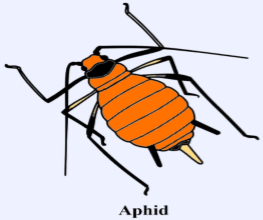
Insects having piercing and sucking mouthparts are
(a)Butterflies
(b)Aphids
(c)Houseflies
(d)Fruit Flies
Answer
489.3k+ views
Hint: Tiny sap-sucking insects and members of the Aphidoidea superfamily are insects that have piercing and sucking mouthparts. Common names include greenfly and blackfly, although individuals may differ widely in color within a species.
Complete answer:
-Piercing and sucking mouthparts or slightly changed ones include aphids, thrips, mites, and true bugs. Insects with chewing mouthparts have mandibles which are teeth-like jaw-like structures. Within the stems or between leaf tissues, they break off and chew plant tissue or tunnel.
Additional Information: -Two pairs of fine, versatile styles are basically made from the mouthparts of aphids: two maxillary styles surrounded by a pair of mandibular ones. These stylets slip on the rostrum (or labium) in a dorsal groove. Depending on the species, the rostrum varies in length.
-Aphids are soft-bodied insects that feed on plant sap using their piercing-sucking mouthparts. They typically occur on the undersides of tender terminal growth in colonies. Because of excessive sap removal, heavily infested leaves may wilt or turn yellow. Although the plant may look poor, good, existing trees and shrubs will usually not be seriously harmed by aphid feeding.
Butterflies have a siphoning type of mouthpart.
Houseflies have a sponging type of mouthpart.
Fruit Flies have a sponging type of mouthpart.
So, the correct answer is, ‘Aphids’.
Note: Aphids create vast quantities of honeydew "sugar liquid waste". The windows and ends of cars parked under infested trees may be spotted by the honeydew that falls from these insects. In honeydew deposits that accumulate on leaves and branches, a fungus called sooty mold may develop, turning them black. The first time an aphid infestation is detected could be the appearance of sooty mold on plants. The drops will attract other insects that will feed on the sticky deposits, such as ants.

Complete answer:
-Piercing and sucking mouthparts or slightly changed ones include aphids, thrips, mites, and true bugs. Insects with chewing mouthparts have mandibles which are teeth-like jaw-like structures. Within the stems or between leaf tissues, they break off and chew plant tissue or tunnel.
Additional Information: -Two pairs of fine, versatile styles are basically made from the mouthparts of aphids: two maxillary styles surrounded by a pair of mandibular ones. These stylets slip on the rostrum (or labium) in a dorsal groove. Depending on the species, the rostrum varies in length.
-Aphids are soft-bodied insects that feed on plant sap using their piercing-sucking mouthparts. They typically occur on the undersides of tender terminal growth in colonies. Because of excessive sap removal, heavily infested leaves may wilt or turn yellow. Although the plant may look poor, good, existing trees and shrubs will usually not be seriously harmed by aphid feeding.
Butterflies have a siphoning type of mouthpart.
Houseflies have a sponging type of mouthpart.
Fruit Flies have a sponging type of mouthpart.
So, the correct answer is, ‘Aphids’.
Note: Aphids create vast quantities of honeydew "sugar liquid waste". The windows and ends of cars parked under infested trees may be spotted by the honeydew that falls from these insects. In honeydew deposits that accumulate on leaves and branches, a fungus called sooty mold may develop, turning them black. The first time an aphid infestation is detected could be the appearance of sooty mold on plants. The drops will attract other insects that will feed on the sticky deposits, such as ants.

Recently Updated Pages
Master Class 11 Economics: Engaging Questions & Answers for Success

Master Class 11 Business Studies: Engaging Questions & Answers for Success

Master Class 11 Accountancy: Engaging Questions & Answers for Success

Master Class 11 English: Engaging Questions & Answers for Success

Master Class 11 Computer Science: Engaging Questions & Answers for Success

Master Class 11 Maths: Engaging Questions & Answers for Success

Trending doubts
State and prove Bernoullis theorem class 11 physics CBSE

1 ton equals to A 100 kg B 1000 kg C 10 kg D 10000 class 11 physics CBSE

State the laws of reflection of light

One Metric ton is equal to kg A 10000 B 1000 C 100 class 11 physics CBSE

1 Quintal is equal to a 110 kg b 10 kg c 100kg d 1000 class 11 physics CBSE

Difference Between Prokaryotic Cells and Eukaryotic Cells




